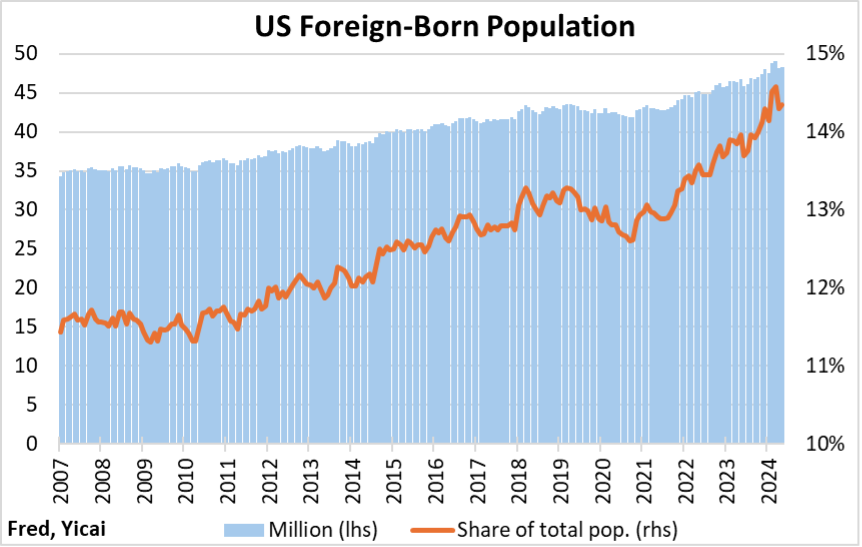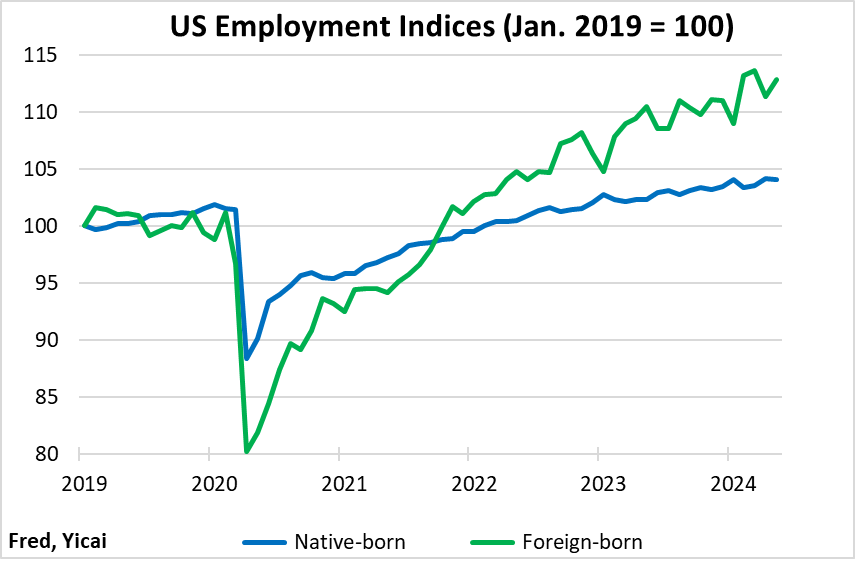 Let’s Get the Facts Straight on Immigration
Let’s Get the Facts Straight on Immigration(Yicai) July 8 -- I recently watched the debate between Joe Biden and Donald Trump.
Mr. Trump made numerous outrageous statements and he deeply misrepresented many economic and political facts.
I would like to examine what he said about immigration because this is not only a critical issue for American voters (especially Republicans) but also because it is one whose impact is felt well beyond the US’s borders.
Moreover, this is a personal issue for me. I come from a long line of migrants. For example, in 1907 my great-grandfather immigrated from what is now Lithuania to Lachine, Quebec – Quebec’s China. One-hundred and twelve years later, I moved from Ottawa to Shanghai.
Mr. Trump accused Mr. Biden of having “allowed millions of people to come in here from prisons, jails and mental institutions to come into our country and destroy our country.”
It is true that the US’s foreign-born population reached record levels during the Biden Presidency (Figure 1). By May, the US’s foreign-born population was 48.3 million, up from 42.3 million in January 2020. Foreign born residents now account for 14.4 percent of the US’s population, up 3 percentage points from January 2007. Looking through the volatility of the Covid period, the rise in foreign-born residents’ share of the population during the Biden Presidency seems to be in line with the trend of the previous decade.
Figure 1

Most of the US’s foreign-born population entered the country through legal channels (Figure 2). In 2021, close to half of its foreign-born population were naturalized US citizens. A further quarter were lawful permanent residents and an additional 4 percent were lawful temporary residents. The 10.5 million unauthorized immigrants – also called illegal immigrants – only accounted for 22 percent of the foreign-born population and just 3 percent of the US’s total population.
Figure 2

Rather than ”destroying” the US as Mr. Trump contends, the US’s foreign-born residents were integral to ensuring a smooth recovery from Covid’s economic dislocation.
In particular, the employment of foreign-born residents rebounded much more sharply than that of native-born Americans. Figure 3 shows that employment of foreign-born residents rose by close to 13 percent between January 2019 and May 2024. In contrast, the employment of native-born Americans was only up 4 percent.
Figure 3

The Covid recovery was not exceptional. Since the mid-2000s, foreign-born workers have made an outsized contribution to the US’s economic development. Their share in total employment rose from 16.5 percent in 2008-09 to 19.5 percent in May (Figure 4).
Figure 4

Mr. Trump accused immigrants of “taking black jobs” and “taking Hispanic jobs” but the data does not support his contention (Figure 5 – the data shown here are 12-month averages).
Even as the share of foreign-born workers in total employment rose during the Covid recovery, the unemployment rates (UER) of native-born Americans declined. May’s UER for native-born Americans is 0.2 percentage points lower than it was, on average, in 2018-19. Recall that 2018-19 was a period when unemployment was already very low by historical standards. The drop in the UER of Black Americans has been even sharper. May’s reading was 0.9 percentage points below the 2018-19 average. For Hispanic Americans, the UER in May was unchanged from 2018-19.
Figure 5

Why did the increased employment of foreign-born residents not lead to greater unemployment for native-born Americans?
It turns out that foreign-born residents’ willingness to work increased while native-born Americans dropped out of the labour force.
Economists like to look at the labour force participation rate – the share of a demographic sub-group that is in the labour force. The labour force participation rate of foreign-born workers has generally been higher than that of native-born Americans. That’s likely because of differing demographic characteristics: foreign-born residents are probably younger than native-born Americans. Nevertheless, the labour force participation rates of the two groups diverged sharply during the Covid recovery period (Figure 6).
Between 2018-19, the labour force participation rate of foreign-born residents was 3.6 percentage points higher than that of native-born Americans. More recently, the gap ballooned to 4.7 percentage points.
Foreign-born residents’ increased willingness to work has been a key factor in maintaining the US’s labour supply and preventing a wage-price inflationary spiral. Instead of “destroying” the country, it would be more accurate to say that foreign-born residents are maintaining it.
Figure 6

The most pernicious statement Mr. Trump made is that “… people are coming in and they’re killing our citizens at a level that we’ve never seen. We call it migrant crime.” This sort of statement suggests that foreign-born residents are more likely to commit murders than native-born Americans. By talking in this way, Mr. Trump demonizes immigrants and sews discord in American society.
Given the stakes, it is important to get the facts right and get the truth out. Luckily, a recent study authored by Alex Nowrasteh of the Cato Institute comes to conclusions that are simple to recall – as easy as 1, 2, 3.
Mr. Nowrasteh looks at homicide convictions in Texas over the period 2013-22. While Texas is only one of 50 states, Mr. Nowrasteh argues that the Texas data provide a representative sample because the state has the second-highest illegal immigrant population (after California), it shares the longest state border with Mexico and has a reputation for strictly enforcing criminal laws. Moreover, Texas diligently keeps data on the immigration status of those arrested and convicted of crimes.
I present Mr. Nowrasteh’s data in Figure 7. The rates are in terms of incidence per 100,000 of each sub-group. In each and every year examined, the homicide conviction rates are lowest for legal immigrants, next lowest for illegal immigrants and highest for native-born Americans. Over the period, the averages are 1, 2 and 3 per 100,000, respectively.
According to Mr. Nowrasteh, “the findings here imply that more immigration enforcement will not bring down crime rates.”
Figure 7

Anti-immigrant sentiment is not solely an American phenomenon. In Europe too, negative feelings toward immigrants have increased in recent years. Thankfully, careful analysis of the data yields a positive story.
Research by Hippolyte d’Abis and co-authors shows that following an inflow of permanent migrants, per capita GDP in European countries increases significantly over the next four years and unemployment levels decrease.
In contrast, an inflow of asylum seekers does not significantly improve economic performance. However, the researchers find no statistical evidence that an inflow of asylum seekers reduced standards of living, increased unemployment or deteriorated public finances. They believe that, after several years, an inflow of asylum seekers may actually have a slight positive effect as they obtain permanent residence, become employed and contribute to the economy of their host country.
How about China?
Because of the immense size of the Chinese labour force, we cannot expect immigration to be large enough to have the same sort of macroeconomic impact as in the US or Europe.
Still, importing foreign expertise can be extremely useful in high-skilled occupations, especially when the supply of local talent is insufficient.
In part because of its unique history, I have always found Shanghai to be particularly open to foreigners (海纳百川). Indeed, in the 1930s, Shanghai welcomed tens of thousands of Jewish refugees who fled the Nazis and who were turned away by almost every other country. And, I must say, I was also always warmly received during my seven years in Beijing and the two that I spent in Tianjin.
Given the anti-immigrant sentiment elsewhere, China can burnish its brand by differentiating itself as a jurisdiction that continues to embrace immigrants.
In addition to helping itself by remaining an immigrant-friendly country, China can also play a useful role in relieving migration pressures elsewhere.
Mexico has been, by far, the single biggest source of unauthorized immigrants to the US. More investment in Mexico would create economic opportunities and increase the incentive for people to remain at home.
My sense is that many Chinese firms would be delighted to invest in Mexico but there is some uncertainty as to how their products would be received in the US. Ensuring that Chinese-invested Mexican firms had full access to the US market under the United States-Mexico-Canada Agreement would be a sustainable and humane way to reduce the inflow of undocumented northbound migrants.